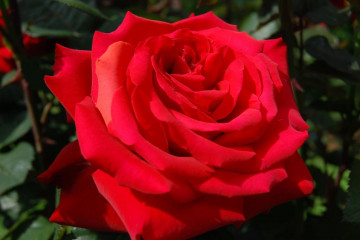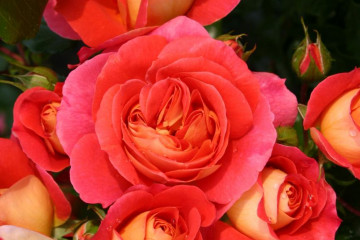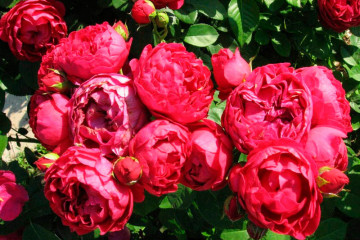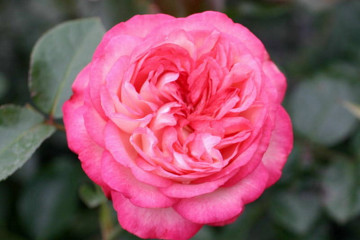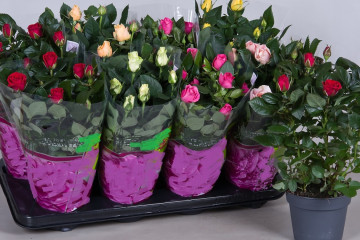Rose Florentina (Florentina) - what is this unique variety
Content:
Among garden flowers, Rosa Florentina takes pride of place. This variety is climbing, valued for its long shoots, lush inflorescences of bright red color. The rose is grown as a bush and also on a stem.
Rose Florentina (Florentina)
A variety of German selection. Florentina was bred by botanists of the famous Kordes nursery for cascade planting in landscape design. It's a hybrid. Does not propagate by seeds, only vegetatively. The rose came to Russia in 2011.

The buds consist of a large number of petals growing chaotically, collected in inflorescences of 5-7 pieces
Brief description, characteristic
The stems of the bush are quite thick, strong, lend themselves well to formation, are able to remember the shape, twist on their own along the support, the whips grow up to 3 meters long. In their natural form, they form a loose spherical crown. The red bud is peony, the core is yellow, not always visible.
Advantages and disadvantages of the variety
Florists appreciate Florentina for many qualities:
- the variety is unpretentious in care, tolerates frost well;
- resistant to black spot, rarely affected by powdery mildew;
- the buds have a rich color, do not fade, do not fade from precipitation;
- up to 100 flowers grow on the bush per season;
- climbing branches brighten up the unassuming details of the landscape.
Now about the cons:
- weak, subtle aroma;
- sometimes shoots have to be additionally secured so that they do not slide off the support;
- in cold years the bush grows late.
Use in landscape design
Florentina rose is suitable for single and group planting of curbs. It is good in open spaces and cascades.
Growing a flower, how to plant it in open ground
Planting material is purchased in stores, nurseries or grown independently.
In what form is the landing
The seed planting method is not welcomed by gardeners; more often they plant parts of bushes, cuttings or layering.
What time is the boarding
Planting material is planted in a permanent place in late autumn, a month before the onset of cold weather or in spring, when the soil warms up to + 10 ° C.
Location selection
The rose grows well in shaded areas in the afternoon, small hills. Prefers loose loam or black soil. In the heated areas, drainage is done before planting.
How to prepare the soil and flower for planting
The soil is well dug up, weeds are removed. Introduce organic matter (a bucket of humus per 1 m²) and complex fertilizers no more than 20 g per 1 m². The shoots are shortened to 30 cm, the roots are dipped into a growth stimulant solution.
Planting procedure step by step
It is important to plant the Florentina climbing rose correctly, then a full-fledged root system will form.
Brief description of the landing procedure:
- Dig a planting hole up to 60 cm deep.
- A drainage with a height of 10 cm is laid at the bottom.
- A mound of earth is poured, the roots of the seedling are set on it so that the root collar is 2.5-3 cm below the soil surface.
- Condensate the soil, water abundantly.
- The trunk circle is mulched abundantly.
Plant care
The main occupations of flower growers in relation to Florentina:
- regular weeding;
- loosening;
- mulching the soil around the bushes.
Watering rules and humidity
Water is used warm, rainwater, settled is best suited. Moisten the ground twice a week by sprinkling. If abundant dew falls, watering is reduced, and on dry days - increased. Up to a bucket of water is poured onto the bush once.
Top dressing and soil quality
In the spring, the shrub needs nitrogen-containing mixtures, feeding is carried out in the phase of active growth. In summer, soluble minerals are needed, which include phosphorus, potassium, and calcium. It is necessary to maintain the acidity at the level of 5.5–6.5, not higher.
Pruning and replanting
Sanitary pruning is done in the spring when the buds swell. Remove frozen and old shoots. For abundant flowering, the branches are pruned so that 5-7 buds remain. For long lashes, the very tip is cut.
Summer pruning involves removing wilted buds. Before wintering, a shaping "haircut" is carried out.
Features of wintering a flower
In areas where there is no severe frost and a lot of snow falls, roses do not require the arrangement of temporary shelters. In temperate latitudes, branches are removed from the supports in autumn, placed on supports so that they do not touch the ground. Throw on top with spruce branches or dry branches. Standard bushes are covered with spunbond or thick film.
Rose bloom, why the flower has no scent
The buds are terry, with a large number of petals. It is believed that they do not smell, but in fact exude a light, delicate scent that combines fruity and floral notes. There are few oils in the petals, ethers are volatile, they rise upward along with the evaporated moisture. For this reason, the aroma does not apply to the entire district.
A period of activity and rest
Flowering begins in June and lasts until September with small intervals of 3 to 5 days.
Care during and after flowering
In the phase of rapid flowering, the plant needs feeding. Fertilizers are added to water for irrigation in a ratio of 1: 5, the prepared solution is diluted five times. After flowering, cut off all the buds, reduce watering, loosen the soil. Florentina needs to prepare for wintering, accumulate nutrients in the roots.
What to do if it does not bloom, possible reasons
The bush does not release buds for several reasons:
- flower buds froze during the wintering period or during severe frosts. The second layer of flowers should appear in 10-12 days;
- too alkaline soil, acidity adjustment is carried out with peat or fresh manure;
- direct sunlight. With too intense light, Florentina's budding stops;
- insufficient watering. When it is dry, the buds that appear stop growing and dry out.
Flower propagation
Like all plants of the pink family, the climbing rose reproduces by dividing the bush, layering, seeds, budding. When propagated by vegetative methods, rooted plants are formed. When the aerial part dies, they grow back again - new shoots are released from the root collar.
Detailed description
Seeds are sown after stratification - they need to be kept in the cold for 4 months. The planting material is deepened by 1 cm, the soil is well moistened, sprinkled with dry fungicide (Fitosporin, Kaptan). Seedlings appear in 4-6 weeks and should be kept out of direct sunlight. Two months after the emergence of sprouts, the bush releases its first buds.
Layers are used to preserve a decorative appearance; the layering procedure is carried out at the very beginning of spring. Branches located in the soil layer closer to the surface are used. They quickly develop roots. Cuttings are taken from adult bushes when the first wave of budding ends. All leaves are removed from the branches, the lower stem is dissected, placed in a growth stimulator for 2 hours, then buried. In this state, the cuttings take root within a couple of months.

The standard rose is grown on a scion. A purchased seedling must have a trunk thickness of at least 1 cm
Diseases, pests and ways to control them
The plant has an average immunity, therefore, fungal diseases are affected only during unfavorable periods. With a contrast between night and day temperatures, rust or gray rot appears, during a period of high humidity and heat - powdery mildew. It is necessary to carry out preventive treatment with fungicides for greenhouse crops. The green cone is treated with Bordeaux liquid.
From insects, the rose is attacked by aphids, a rose-colored sawfly. Insecticides are effective against them. Omnivorous spider mites get rid of intestinal acaricides.
The climbing rose Florentina is unpretentious, blooms profusely, fades beautifully. She will decorate any corner of the garden, give it a unique flavor. With proper care, it will delight with buds until September.




